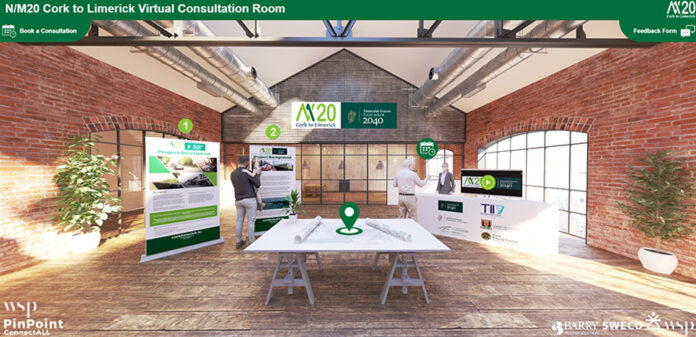
CONSULTATION undertaken for the N/M20 Cork to Limerick Project in recent months generated unprecedented levels of public engagement with over 40,000 interactions received using a range of avenues available through the N/M20 Project Office.
Public health restrictions as a result of the Covid-19 pandemic saw a new approach to public consultation developed using a project-specific Virtual Consultation Room supported by online and telephone consultation meetings and feedback channels via email, the project website and post.
Figures released by the Project Office show that 38,375 views took place of the Virtual Consultation Room which explained the project background and development process, the road-based and rail-based options being examined, the potential for active travel and the consultation process itself. The Virtual Consultation Room’s interactive mapping allowed those viewing to identify houses, premises and land holdings on any of the options being examined.
In addition to visits to the Virtual Consultation Room at CorkLimerick.ie, the project team undertook 726 online or telephone consultations, received 1,091 feedback forms, 1,150 emails, 460 telephone calls and attended online public meetings. The consultation commenced on 19 November 2020 and was later extended to 15 January 2021, following requests.
Jari Howard, N/M20 Project Coordinator said “By any criterion, this was a very significant and successful public consultation. Notwithstanding the use of a format that would have been new to many people, there was a tremendous level of constructive engagement. We advertised the public consultation on multiple national and regional media, circulated over 5,000 letters directly in the study area and people availed of our team’s availability to meet through a simple booking system.”
“The online format of the consultation has led to much higher levels of public engagement than normally experienced and these new methods will become an integral part of all future consultations for this project, along with the traditional public display events and physical meetings once the public health guidance permits same.”
“We achieved our objective to engage with the public, increase understanding of the project and to capture local knowledge which may have been unknown to the project team. The feedback and submissions received through this public consultation will be considered by the project team in Stage 2 of the option selection process. This will involve further refinement of the road-based and rail-based options followed by appraisal under the following criteria: Safety, Economy, Environment, Accessibility and Social Inclusion, Integration and Physical Activity.”
The Stage 2 assessment and appraisal will lead to the identification of the best performing option or combination of options, which will be taken forward as the preferred option.
The preferred option will be presented at a future public display, which is expected to take place later this year.
The project team will then engage directly with householders, land and all property owners, including businesses and other stakeholders along the preferred option as the design is developed.


